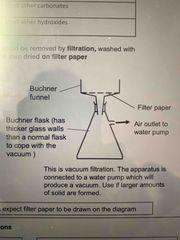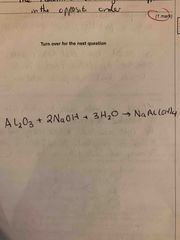![]()
![]()
![]()
Use LEFT and RIGHT arrow keys to navigate between flashcards;
Use UP and DOWN arrow keys to flip the card;
H to show hint;
A reads text to speech;
33 Cards in this Set
- Front
- Back
- 3rd side (hint)
|
Why is there is a small drop between Mg + Al in ionisation energy? |
Mg has its outer electrons in the 3s sub shell, whereas Al is starting to fill the 3p subshell. Al’s electron is slightly easier to remove because the 3p electrons are higher in energy. |
|
|
|
Why is there is a small drop between phosphorous and sulphur in ionisation energy? |
Sulphur’s outer electron is being paired up with an another electron in the same 3p orbital. When the second electron is added to an orbital there is a slight repulsion between the two negatively charged electrons which makes the second electron easier to remove. |
|
|
|
Magnesium burned in air (oxygen) |
Mg burns with a bright white flame. 2Mg + O2 2MgO MgO is a white solid with a high melting point due to its ionic bonding. |
|
|
|
Steam and Magnesium |
Magnesium reacts in steam to produce magnesium oxide and hydrogen. The Mg would burn with a bright white flame. Mg (s) + H2O (g) MgO (s) + H2 (g) |
|
|
|
The other group 2 metals will react with cold water equations (not magnesium) |
Ca + 2 H2O (l) Ca(OH)2 (aq) + H2 (g) Sr + 2 H2O (l) Sr(OH)2 (aq) + H2 (g) Ba + 2 H2O (l) Ba(OH)2 (aq) + H2 (g) |
|
|
|
Group 2 reactions with cold water |
One would observe: fizzing, (more vigorous down group) the metal dissolving, (faster down group) the solution heating up (more down group) with calcium a white precipitate appearing (less precipitate forms down group with other metals) |
Observation |
|
|
Steps in extracting titanium |
TiO2 +2Cl2 +2CTiCl4 +2CO Titanium is extracted by reaction with a more reactive metal (e.g. Mg).1. 2. 3. TiO2 (solid) is converted to TiCl4 (liquid) at 900C: The TiCl4 is purified by fractional distillation in an argon atmosphere. The Ti is extracted by Mg in an argon atmosphere at 500C |
|
|
|
Group 2 hydroxides solubility |
Group II hydroxides become more soluble down the group. All Group II hydroxides when not soluble appear as white precipitates. |
|
|
|
Group II sulfates |
Group II sulfates become less soluble down the group. BaSO4 is the least soluble. |
|
|
|
Filtration step up |

Back (Definition) |
|
|
|
Reaction with Flouride/Chloride and concentrated sulfuric Acid -observations and Equations |
NaF (s) + H2SO4(l)NaHSO4(s) + HF(g) Observations: White steamy fumes of HF are evolved. NaCl(s) + H2SO4(l)NaHSO4(s) + HCl(g) Observations: White steamy fumes of HCl are evolved. |
Equation and observation |
|
|
Iodide with concentrated sulphuric acid |
Observations: White steamy fumes of HI are evolved. Black solid and purple fumes of Iodine are also evolved A colourless, acidic gas SO2 A yellow solid of sulfur H2S (Hydrogen sulfide), a gas with a bad egg smell, NaI(s) + H2SO4(l)NaHSO4(s) + HI(g) 2HI+H2SO4I2(s) + SO2(g) + 2H2O(l) 6HI+H2SO4 3I2 +S(s)+4H2O(l) 8 HI + H2SO44 I2(s) + H2S(g) + 4 H2O(l) |
Equation and observation |
|
|
Chloride with water |
Cl (g) + HO(l)⇌ HClO(aq) + HCl(aq |
Equation |
|
|
Chloride Reaction with water in sunlight |
2Cl2 + 2H2O4H+ + 4Cl- + O2 The same reaction occurs to an equilibrium mixture of chlorine water when standing in sunlight. The greenish colour of chlorine water fades as the Cl2 reacts and a colourless gas (O2) is produced. |
equation |
|
|
Reaction of chlorine with cold dilute NaOH solution |
Cl2,(and Br2, I2) in aqueous solutions will react with cold sodium hydroxide. The colour of the halogen solution will fade to colourless. Cl2 (aq) + 2 NaOH (aq) NaCl (aq) + NaClO (aq) + H2O (l) The mixture of NaCl and NaClO is used as bleach and to disinfect/ kill bacteria. |
Equation and uses of products |
|
|
Observation of period 3 reactions with oxygen |
The elements all react with oxygen to form oxides. Sodium burns with a yellow flame to produce a white solid Mg, Al, Si and P burn with a white flame to give white solid smoke S burns with a blue flame to form an acidic choking gas. |
|
|
|
Amphoteric Oxides Aluminium acting as acid and base |
Aluminium oxide can act as both an acid and an alkali and is therefore called amphoteric Aluminum oxide acting as a base Al2O3 (s)+ 3H2SO4 (aq)Al2(SO4)3 (aq) + 3H2O (l) Al2O3 + 6HCl2AlCl3 + 3H2O Aluminum oxide acting as a acid Al2O3 (s)+ 2NaOH (aq) + 3H2O (l) 2NaAl(OH)4 (aq) |
|
|
|
Si02 acting as acid And why only acts as acid |
SiO2 has a giant covalent structure with very strong bonds. This stops SiO2 dissolving or reacting with water and weak solutions of alkali. It will, however, react with very concentrated NaOH 2NaOH (l) + SiO2 (s) Na2SiO3 (aq) + H2O |
|
|
|
What is an Transition Metal |
incomplete d sub-level in atoms or ions |
|
|
|
Transition Metal Properties |
complex formation, • formation of coloured ions, •variable oxidation state •catalytic activity |
|
|
|
How colours arise- Transition Metals |
Colour arises from electronic transitions from the ground state to excited states: between different d orbitals. A portion of visible light is absorbed to promote d electrons to higher energy levels. The light that is not absorbed is transmitted to give the substance colour. |
|
|
|
Changing colours- Transition Metal |
Changing a ligand or changing the coordination number will alter the energy split between the d- orbitals, changing E and hence change the frequency of light absorbed. |
|
|
|
Spectrophotometry Method ( Colourimtery) |
Add an appropriate ligand to intensify colour Make up solutions of known concentration Measure absorption or transmission Plot graph of absorption vs concentration Measure absorption of unknown and compare |
|
|
|
Vanadium colours |
VO2+ Oxidation state +5 ( a yellow solution) VO2+ Oxidation state + 4 (a blue solution) V3+ Oxidation state + 3 (a green solution) V2+ Oxidation state + 2 (a violet solution) |
|
|
|
Manganate Redox Titration |
MnO4-(aq) + 8H+ (aq) + 5Fe2+ (aq)Mn2+ (aq) + 4H2O (l) + 5Fe3+ (aq) Purple to colourless |
Equation and observation |
|
|
Vanadium colours (You better get vanadium) |
VO2+ Oxidation state +5 ( a yellow solution) VO2+ Oxidation state + 4 (a blue solution) V3+ Oxidation state + 3 (a green solution) V2+ Oxidation state + 2 (a violet solution) |
|
|
|
How does Catalyst Poisoning occur? |
Catalysts can become poisoned by impurities and consequently have reduced efficiency. |
|
|
|
2+ ion summary |

Back (Definition) CuCl4 is green FeCl4 is yellow |
Observations and Equations Cu and Fe |
|
|
3+ ion summary |

Back (Definition) |
Fe and Al Observations and Equations |
|
|
Equation for Al2O3 and sodium hydroxide |

Back (Definition) |
|
|
|
poisoning reduces effectiveness of a heterogenous catalyst because the... |
the poison attaches to the surface and blocks active site/ surface |
|
|
|
reasons why spectrometer can be appropriate i |
- Rapid determination of concentrations -Does not use up any of the reagent/does not interfere with the reaction -easy to get many readings -possible to measure very low concentrations |
|
|
|
What changes ∆E? |
-(Identity of the) metal -Charge (on the metal) / oxidation state / charge on complex -(Identity of the) ligands -Co-ordination number / number of ligands -Shape |
|

